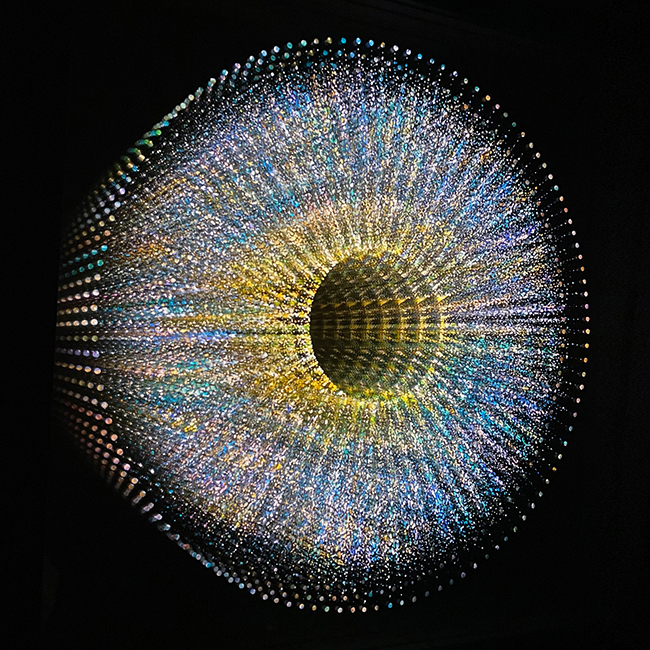Simona Petrauskaite doesn’t just create art. She builds visual puzzles—geometric, glowing, and infinitely deep. Born in Lithuania and based in Bavaria since 1994, she has carved a quiet but unmistakable path as an independent infinity mirror artist. Her work isn’t loud, but it lingers. It doesn’t shout for attention—it pulls you in with repetition, rhythm, and light.

Petrauskaite’s art comes from a personal fascination with how we experience the world. She’s interested in crystals, sacred geometry, energy, and the illusions that live between matter and perception. That list might sound lofty, but her execution is grounded—wood, mirrors, LEDs. These are the raw materials she shapes into works that feel like tunnels into something unspoken.
Her piece titled CODE is a good place to start. Built within a wooden frame, it uses carefully placed mirrors and lights to create a dot-pattern that extends endlessly, thanks to reflection and repetition. It’s minimal on the surface—just points of light in rows and lines—but the result is anything but simple. You don’t just look at CODE; it looks back at you, pulling your eye down a path that seems to never end. You’re left wondering what’s real, what’s just a trick of the light, and why your mind keeps searching for an answer inside it.
That’s the kind of experience Petrauskaite seems to be after. She isn’t painting landscapes or figures. Her world is one of structure—lines and dots, geometry and repetition. But within that structure is a question: what do you see when your senses are being subtly tricked? What do you trust—your eyes, your thoughts, or your feeling?
Much of Petrauskaite’s work sits at that intersection: between physics and mysticism, between sculpture and illusion. The phrase “infinity mirror” refers to a specific technique, often involving two mirrors placed opposite each other, bouncing reflections back and forth to create the illusion of depth. But for her, this technique is more than visual—it’s a conceptual tool. By using mirrors and LEDs, she turns light into a language. Every line of light becomes a sentence. Every repeating pattern, a kind of poem about existence.
Her fascination with sacred geometry isn’t just aesthetic. She draws from patterns that appear across nature and spiritual systems—the flower of life, crystalline lattices, spiral forms. These elements don’t scream at you from the surface of her work, but they whisper just beneath it. You sense them in the balance, in the symmetry, in the way her compositions never feel arbitrary. There’s an order at play, even when the image feels abstract.
Though her style leans toward the minimal and abstract, it doesn’t feel cold. Instead, it invites. Petrauskaite doesn’t fill space with clutter. She clears it, opens it, and then leaves you to wander through it. That makes the viewing experience both active and personal. You’re not just seeing a finished piece—you’re participating in it. Your reflection is part of the work, and the illusion only exists if someone’s there to be caught in it.
Living and working in Bavaria, far from the typical centers of contemporary art, Petrauskaite has developed her practice independently. That independence shows in her work. There’s no clear allegiance to current trends or galleries. Instead, there’s focus—on light, on form, on the question of what art can make us feel, even when there’s nothing recognizable to grab onto.
Her use of repetition is particularly striking. Dots and lines are not just decorative—they’re the core of her language. Repeated over and over, they create rhythm, motion, and eventually, meaning. It’s not unlike a mantra: repetition becomes a kind of meditation. The more you look, the deeper it goes.
And then there’s the light. Petrauskaite’s work wouldn’t exist without it. LEDs are not just there to illuminate—they arethe art. Light becomes shape, depth, vibration. And in that play of light and reflection, you get a glimpse of something almost spiritual. Not in a preachy or symbolic way, but in the sense that you feel changed, even if just slightly, after standing in front of it.
In the end, Petrauskaite isn’t trying to tell you what to think. She’s giving you a space to think in. Or better yet, to stop thinking for a while and just feel your way through the illusion.
Simona Petrauskaite’s art doesn’t offer easy answers. But if you let yourself pause and enter the mirror, you might come out seeing things—inside and outside—a little differently.

